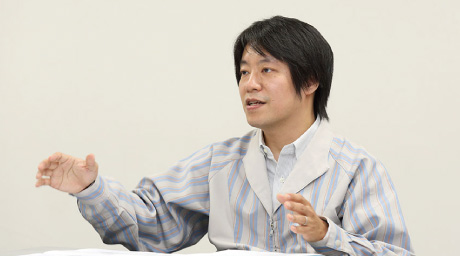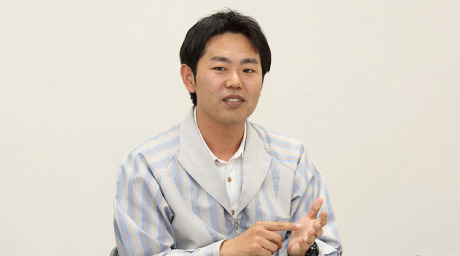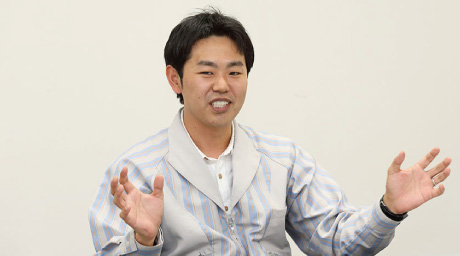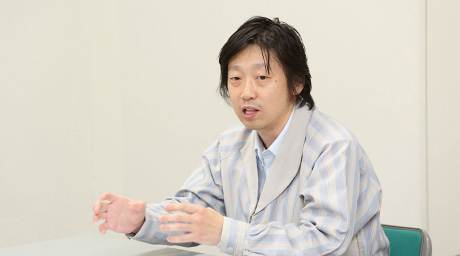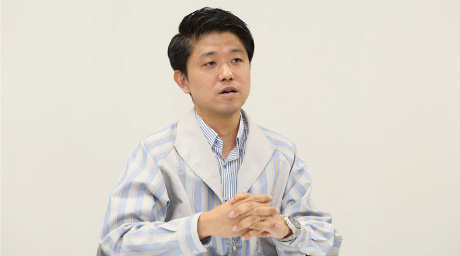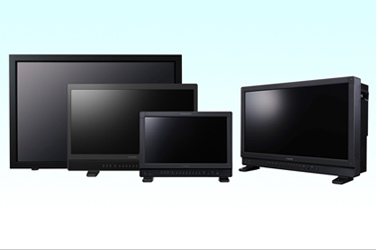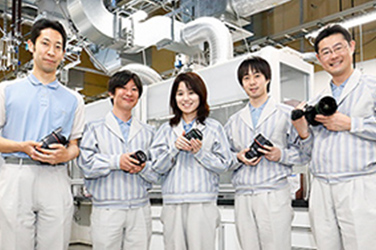4K projector The story behind the development of the 4K500ST 4K projector
The 4K500ST 4K projector combines a compact body with the ability to project exquisite images. How did the development team meet the challenge of developing a compact 4K projector capable of projecting such high-quality images?
POINT 1
Canon optical technology
Creates Immersive Images.

This innovative projector displays even the most elaborate architectural details on a building, the petals of colorful blossoms in a vast meadow, or a canal-side townscape as gondolas drift by. Crisp images of sculptural details and the minutiae of flowers are projected in exquisite detail on a large screen right in front of your eyes. The realism of the images makes you feel as if you're immersed in the scene itself.
The REALiS 4K500ST (XEED 4K500ST in other regions) was developed as Canon's flagship 4K projector with the aim of combining bright, beautiful images with a compact, lightweight body.
The key to the high image quality of this projector is Canon's proprietary optical system — known as the Aspectual Illumination System, or AISYS for short — and the company's new dedicated 4K wide zoom lens. This cutting-edge image projection system is the fruit of Canon's accumulated know-how and the diligence of its engineers.
Takehiro Koyama
Mechanical design
I've just seen a demonstration of the 4K500ST. The 4K video remained in perfect focus across every inch of the large screen, creating an overwhelming sense of realism. In the scene with the gondola floating down the canal, I felt as if I were riding in the gondola myself.
What's more, I was surprised to see that the 4K500ST projector is extremely compact and lightweight, yet it can project such sharp images at a brightness of 5,000 lumens. Although, to be honest, I had had the impression that conventional 4K projectors were intended for commercial use, as they tend to be large and heavy.
How did you come up with the product concept for the 4K500ST?
Takehiro Koyama
In general, conventional 4K projectors can be divided into two categories: commercial models for digital cinema and events in large auditoriums, and general-purpose models intended for home theaters. However, to date there haven't been any bright, compact and lightweight models for events and exhibitions at galleries and museums.
This is still a niche market, but we predict steady growth, and so we decided to launch a competitive model that incorporates various Canon technologies.
The 4K500ST 4K projector is the world's smallest and lightest in its class. In fact, it is significantly smaller than any other product capable of projecting 4K or higher resolution images at 5,000 lumens.* What major technical hurdles did you have to overcome to achieve this?
*As of January 12, 2016, based on a Canon survey
Koyama
Thankfully, we have AISYS, Canon's original illumination and optical system technology. AISYS offers a significant advantage, enabling a compact and lightweight projector to generate bright images. Canon projectors are differentiated from competitor models in that their mechanics were developed to accommodate AISYS technology. Of course, the development team was aware of the difficult hurdle of developing a compact and lightweight 4K projector capable of 5,000-lumen brightness. However, it's an area in which Canon has demonstrated strength in the past.
Junya Ichimura
Optical design
Please give us a detailed explanation of the characteristics of AISYS.
Junya Ichimura
High-end projectors are designed to incorporate a flat panel technology known as Liquid Crystal on Silicon, or LCOS for short. The conventional LCOS method divides a light beam emitted from a lamp into three paths displaying the three primary colors: red, green and blue, or RGB. Canon's LCOS method, however, provides a structure that divides a light beam into two paths: one that is green, or G, and one that is red and blue, or R+B. This makes it possible to reduce the area of the optical unit significantly.
Compared with the three-path method, however, the two-path method — comprising G and R+B, as I mentioned — makes it more difficult to integrate brightness and contrast without highly precise control of the optical characteristics.
Canon's proprietary AISYS illumination and optical system achieves this by drawing out the full potential of LCOS. Such a compact, high-performance illumination and optical system results from the technical expertise Canon has accumulated over the years. The 4K500ST 4K projector incorporates this technology, which provides a high level of brightness in a compact body.
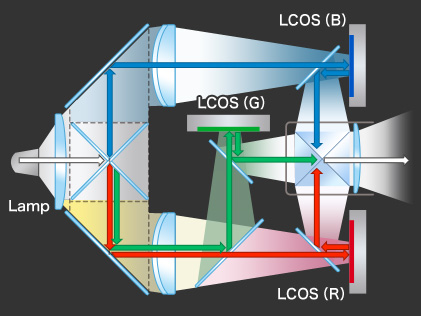 Conventional LCOS system
Conventional LCOS system
 LCOS system incorporating Canon's proprietary AISYS
LCOS system incorporating Canon's proprietary AISYS
The video below presents the principle of the optical system (structured to divide the beam in two)
Principles of the optical system
When projected on a large screen, every part of the image is clearly in focus. Is it the performance of the lens that achieves this?
Ichimura
Yes. The 4K500ST was developed with the goal of achieving a level of resolution suitable for a flagship product. The most significant impact of 4K technology is apparent in the lens. When trying to achieve an image with four times as many pixels as WUXGA resolution, existing lenses simply cannot deliver. To put it in extreme terms, the lens resolution must be doubled, which makes the manufacturing process that much more difficult.
We set out to achieve even higher adjustment accuracy during the assembly process, as well as improve the basic performance of the lens unit. In developing a new lens for this model, we thoroughly reviewed the structure of the lens unit and the materials used. A special glass that's rarely used in conventional projectors became an important component of this product.
The lens unit is a newly developed short-focus zoom lens composed of 16 elements in 12 groups. Each group of lenses moves independently during zoom and focus adjustment. Compared with conventional projector lenses, the 4K500ST's lens was designed to display wider angles with a larger depth of field, specifically an F-number of 2.6, so that projected images remain in clear focus even at the periphery of the screen. Additionally, the lens makes the projector well suited for information-heavy simulation applications. This level of performance can't be expressed succinctly in a catalog. So, we hope customers will take the opportunity to see the projector in action.
Canon's factory in Japan that produces the 4K500ST is adjacent to the Optics R&D Center where the development division is located. This factory handles the manufacture of high-performance lenses, and spans product lines ranging from replacement lenses for digital single-lens reflex cameras to television broadcast lenses, right?
Ichimura
It definitely contributes to the high technological capabilities of the 4K500ST. The lens unit of this model incorporates two ground aspherical lenses at the front. Conventional aspherical lenses are manufactured by pressing glass in a mold. However, ground aspherical lenses, as the name suggests, are produced by literally grinding the glass to form the aspherical surface. This process enables the creation of large high-precision lenses up to 79 mm in diameter. This can be achieved thanks to the sophisticated manufacturing technology of Canon's Japanese plants.
The 4K500ST lens unit features a red line around its barrel. I've heard that the red line represents exceptionally high image quality, is that correct?
 The lens unit featuring the red line
The lens unit featuring the red line
Ichimura
Yes, the red line was first featured on Canon's L-series of luxury lenses for interchangeable lens cameras, and can only be found on input and output devices that achieve the apex of image quality.
During the planning stage for the 4K500ST, we set out to develop a projector lens with the highest level of performance ever and we are really pleased that it is part of Canon's first projector to feature the red line.
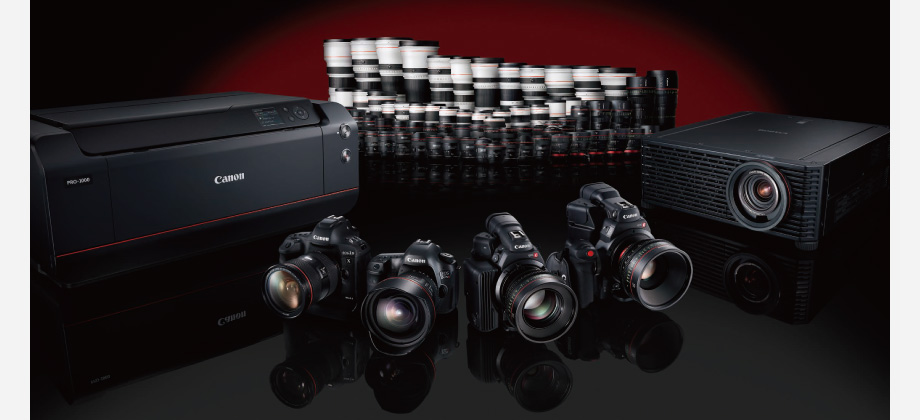 Canon input and output devices featuring the red line
Canon input and output devices featuring the red line
In the demonstration, I was surprised that the projected image remained clearly in focus even when projected onto a curved or uneven screen.
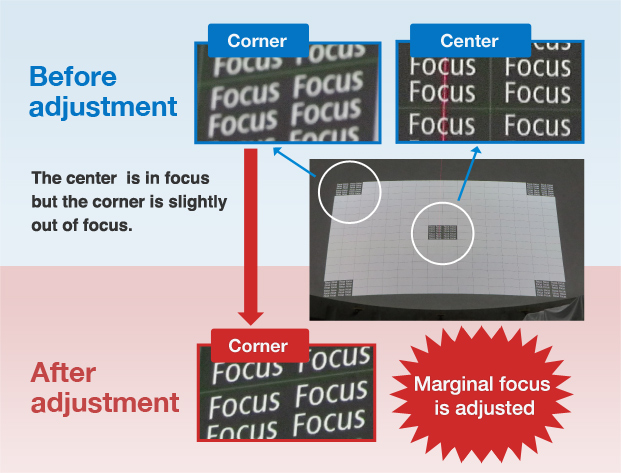 Marginal focus is adjusted
Marginal focus is adjusted
Ichimura
Of course it is assumed that projectors will be used to project images on a flat screen. With the 4K500ST, however, we wanted to incorporate the capability to project images on curved surfaces, such as a dome-shaped screen. With existing models, this can be achieved by adjusting the depth of field, even if the screen surface is somewhat curved or uneven. However, with high-definition 4K, images can easily get out of focus with even the slightest shifting of the screen. To overcome this problem, we added a dedicated lens group just for peripheral focus correction. This group is separate from the lens groups for zooming and conventional focusing. This structure provides the 4K500ST with optical focus adjustment instead of image correction capability, enabling it to project in-focus images on curved surfaces like a dome-shaped screen.
POINT 2
The mechanical design expertise required to combine low-noise operation and a compact body size

In order to achieve a high-brightness projection system in a compact body, it is essential to cool the components that tend to generate heat. When designing the mechanical aspects and electronic circuitry of the 4K500ST, the engineers sought to create the optimum design through trial and error while occasionally clashing with one another.
When I heard that the 4K500ST can project 4K images at a brightness of 5,000 lumens, I assumed it would have a noisy cooling fan. But it's actually very quiet, so it holds its own against other projectors intended for use in conference rooms in that regard.
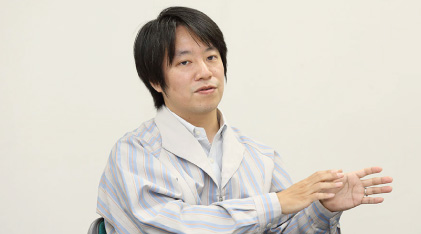
Koyama
If the internal structure is tightly integrated, it can be difficult to provide efficient cooling. On the other hand, if cooling becomes the priority, the size of the projector increases. The challenge is to combine quiet operation with a compact design.
When considering the layout with regard to fans and ducts, you have to consider how efficiently each unit is cooled when air is drawn in from the front of the projector and discharged through the back. Analyzing and verifying these factors took us quite a long time.
We used fluid analysis software on a PC to perform airflow simulations, but we couldn't apply the calculations directly. We created a model duct with a 3D printer and conducted experiments repeatedly to ensure the results matched the simulation data. The hardest task was to verify all the data, because the projector has a lot of cooling points.
Did you encounter any problems that required a major design change?
Koyama
The heat generated by certain devices was greater than expected because of specification changes that were made mid-development. Since the optimal mechanical configuration was decided during a review of the cooling performance, it was rather difficult to cope with these significant design changes.
And so, estimates made during the first phase of review became very important. I would say that 80% of the product's performance was determined at this stage.
In particular, in order to process 4K images, the 4K500ST requires components capable of providing several times the processing speed of a conventional projector. So, we assumed from the outset that the components would generate considerable amounts of heat.
Kazuyuki Kuratomi
Electrical design
Kazuyuki Kuratomi
We had to obtain accurate data on the heating values of the devices in advance, and this was an onerous task. Collaborating with other development divisions, we performed a number of simulations and, together with the mechanical engineers, repeatedly analyzed the data we obtained. We discussed the layout of components on the printed circuit board (PCB) thoroughly in the initial stage, so that devices generating heat would not be located in the same air path, in other words—in the flow path of the cooling air.
"It's difficult to install a PCB in such a small space!"
"I'll try to provide a bit more space. Do what you can to make it fit!"
I had disagreements with the mechanical engineers about the component layout [laughs], but we discussed the matter doggedly until we convinced each other. It took several months to determine the component layout and PCB size.
Did you ever have any disagreements with the other engineers?
Kuratomi
We had some frank arguments, but this just brought us closer together. By engaging in thorough discussions at the initial stage, we determined the optimum component layout, which resulted in the cooling performance we had been aiming for. We shared the goal of creating a high-performance 4K projector that was smaller than any other model. So it just goes to show that, when it comes to designing a product, communication is essential.
POINT 3
Smooth, clear image projection achieved by persistence in overcoming challenges

Achieving the smooth display of high-resolution 4K images at 60 frames per second has two requirements: precision control of the LCOS panels and image engine processing. The 4K500ST adopts an innovative new panel drive system and image engine.
Masayuki Abe
LCD device design
To display 4K 60P video smoothly, panel control is also important. Did you have any difficulty with this aspect?
Masayuki Abe
Because of the advanced technology required, I had some difficulty designing the LCOS panels to provide high resolution without sacrificing the projector's compact body. 4K resolution (4,096 x 2,400 pixels) represents 9.8 million pixels, which is about four times the 2.3 million pixels of conventional WUXGA (1,920 x 1,200 pixels). What's more, to retain the compact size of the projector, the LCOS panel of the 4K500ST was designed to be the same size in inches as that used for a WUXGA projector. So, the area per pixel of a 4K image is only one-fourth that of a WUXGA image. When handling such a large quantity of small pixels, panel control becomes incredibly difficult. For example, some pixels that should be light might end up dark because of voltage levels. This phenomenon is attributable to a problem related to the principle that an area close to a boundary of pixels darkens on an LCOS panel in the case of certain combinations of images. With the 4K500ST, the pixels on the LCOS panel are extremely small because they are projecting high definition, but the ratio of dark areas at the boundary was also high, making them conspicuous in appearance.
We set out to solve this problem through trial and error. Finally, the combined effort of the team resulted in the development of Canon's proprietary new drive system, which succeeded in projecting smooth images by lightening dark pixels.
Yuichi Ishiwata
Image quality design
The image engine also plays a significant role in projecting images with vivid colors, correct?
Yuichi Ishiwata
To be able to handle 4K images, the 4K500ST is driven by two engines, working in parallel, processing the right and left sides of the screen separately.
To improve viewing quality for video, the 4K500ST incorporates a "motion blur reduction" function. Can you explain how this function works?
Ishiwata
Normally, an LCD panel holds an image frame until it shifts to the next one. Therefore, due to the characteristics of the human visual system, an afterimage persists in the mind. The motion blur reduction function reduces the prevalence of this afterimage. This function is incorporated into conventional Canon projectors as well, but the 4K500ST adopts a new method that allows even small text to be read clearly. This function seems to offer an advantage, particularly in applications that require high-speed motion and clear expression of minute details such as simulations.
In addition, the image engine includes a "shape tracing" function. This improves image quality when 2K images are upscaled to 4K resolution. Conventionally, bicubic interpolation is used to interpolate pixels, a method that makes use of the information in adjacent pixels. However, diagonal lines tend to look jagged when the bicubic method is used alone, and applying processing to suppress these jaggies can result in the image appearing blurred.
The 4K500ST's shape tracing function detects diagonal lines, such as those found in an image of a building, and interpolates pixels based on this information, minimizing jaggies while creating an image with the perceived high level of resolution achieved by high-resolution panels.
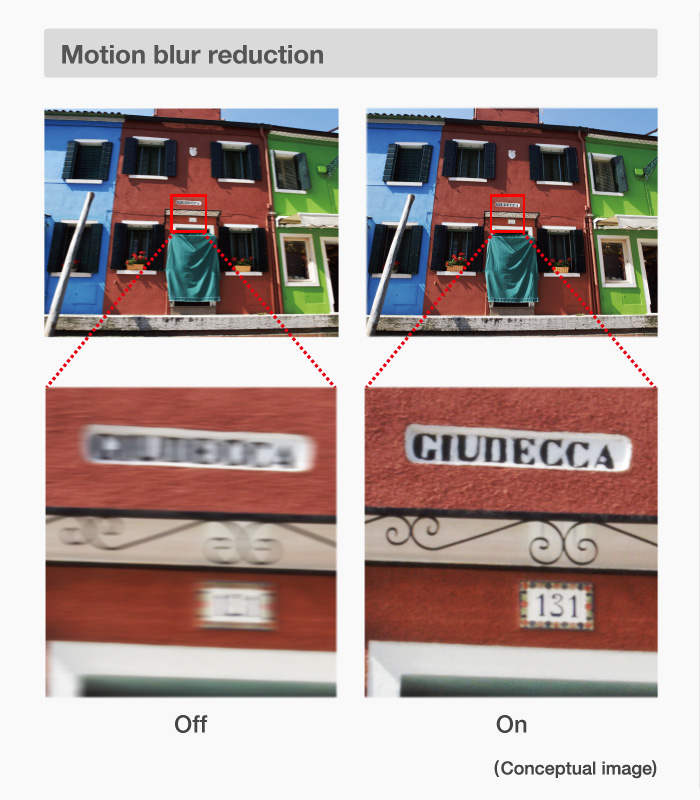
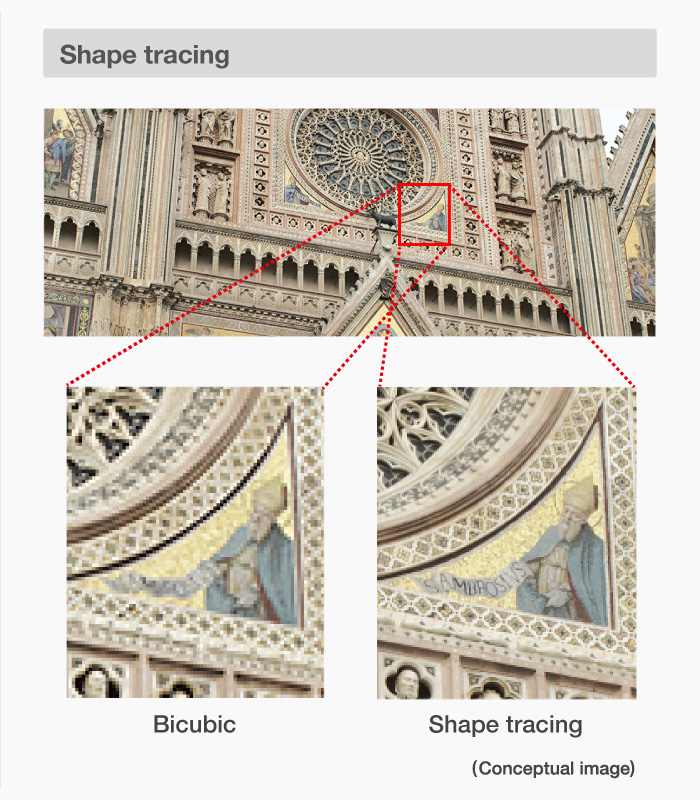
POINT 4
The compact 4K projector that heralds a new imaging market

The 4K500ST is capable of projecting high-definition 4K images, and when multiple units are used in tandem, can even project 8K images. The combination of high image quality in a compact, lightweight body is revolutionizing the imaging market.
A compact projector that is actually capable of projecting 4K images must have an extremely wide range of applications, right?
Koyama
The 4K500ST provides 2,400 pixels vertically, which is more than that normally generated by a general-purpose 4K display or projector. Thanks to this feature, when four 4K500ST projectors are combined to project 8K images, viewers can see true 8K images, without any noticeable seams.
High-definition 4K and 8K images are useful in a variety of applications, particularly with highly creative content such as projection mapping, digital signage, attractions and simulations.
In April 2016, after development was finally complete, the 4K500ST was successfully launched. Which aspect of the creation process appealed to you the most?
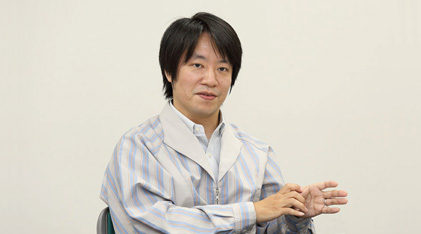
Koyama
The development hurdles for this product were extremely high. We had amassed quite a bit of expertise and a number of conventional technologies, but they weren't enough. We experienced some failures and followed up with a trial-and-error process. By repeating this process, we were able to devise new ideas and discover solutions by ourselves. To me, that's the most interesting aspect of product development.

Abe
From a technical standpoint, achieving such a high resolution with small-sized LCOS panels, the 4K500ST is quite advanced. To achieve satisfactory image quality, we had to overcome various obstacles. However, after completing this product, we were greatly impressed by the sense of immersion and just how impressive the 4K images are. I think the appeal of this kind of work is the sense of achievement you get.
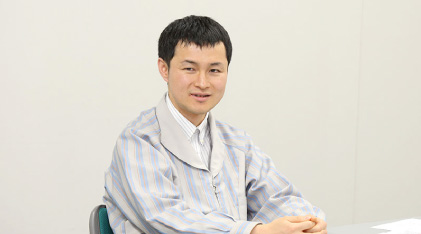
Ishiwata
In developing the 4K500ST, the initial hurdle of playing back the 4K video for evaluating image quality was higher than expected. Also, because of the shortage of suitable 4K content, we had to shoot our own. We faced a number of challenges because the image quality design that leverages the 4K panels was more complex than that of existing WUXGA-panel models. After gaining more experience and expertise from this project, we're thinking about what to aim for next, and how we can overcome that challenge. I think that's the most enjoyable aspect of development. Hearing customers feedback regarding the functions that we incorporated into the product after overcoming various hurdles also encourages us to move on to the next challenge.
I think this development story is an interesting one for students aiming to be engineers. Do you have a concluding message for them?
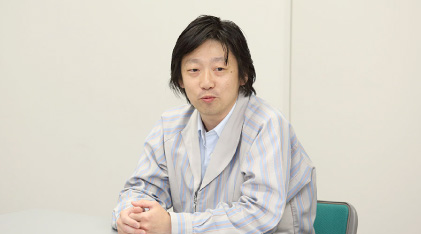
Kuratomi
As the engineers responsible for development, we were the first to see the 4K and 8K images projected by the 4K500ST. We were quite impressed, because we had faced many hardships coming up with a design capable of handling the high-speed transfer of large volumes of data in addition to improving the internal cooling. I hope that those students hoping to become engineers will be able to experience the same sense of accomplishment and be as satisfied as we were after overcoming difficulties in the design process.
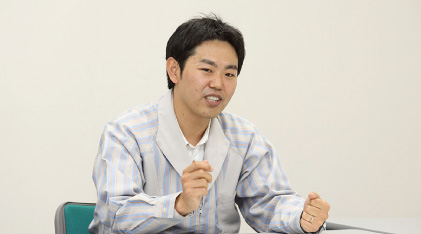
Ichimura
Being involved in such a challenging project, I was excited to have benefitted from more inspiration than I had expected. Working toward such an ambitious goal was tough, but nothing can beat the feeling of having your latent talent drawn out to meet a challenge.
There is room for further development in the optics field. So I hope we can work together.
The market for 4K imaging equipment — including TVs, projectors, smartphones and cameras — is growing rapidly. 4K TVs account for at least 50% of the entire flat-panel TV market in Japan.* MarketsandMarkets, a U.S. research company, reports that the 4K market totaled $18.1 billion in 2014 and will expand to $102.1 billion by 2020. As for content, communication satellite broadcasting, cable television broadcasts and video distribution services have begun transmitting 4K content. Moreover, 4K shooting is becoming increasingly popular on smartphone cameras.
4K images contain four times more dots (pixels) than WUXGA images. This complicates the projection of high-resolution "clear" images.
This increase in the quantity of pixels results in quality changes, dramatically enhancing the realism along with the amount of information transmitted. The compact, lightweight 4K500ST projector is supporting the creation of innovative content and new businesses reliant on ideas, such as mobile museums and theme parks, as well as weather simulation, city planning, and realistic driving simulators.
Our experience with imaging technology will lead to completely different products in the future. The 4K500ST projector will help to drive this movement forward.
*As of April 2016 (total sales basis), according to a JEITA survey
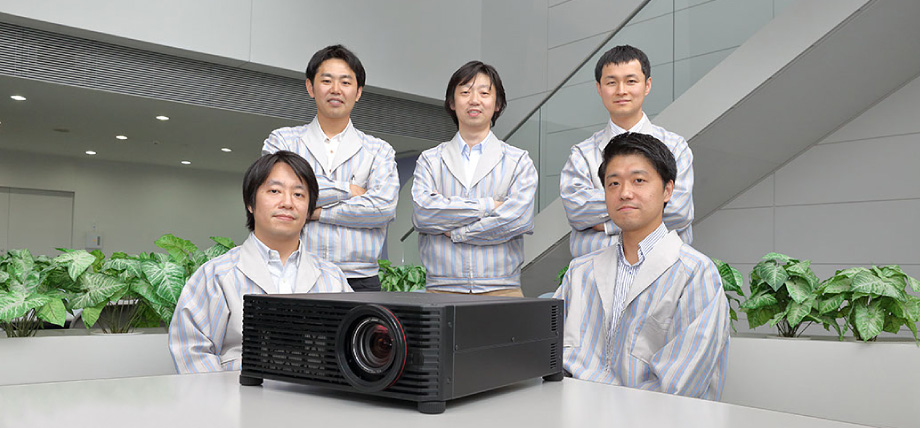
Interview & Composition
Tatsuya Yamaji
Born in 1970. After working as a magazine editor, he became a freelance writer/editor and has been active as a researcher, interviewer and writer in the fields of IT, science and the environment.
Publications include The Day Apple and Google Become Gods (co-author), New Guide to Superconductivity, 72 Hours of Google (co-author), Affirmation (co-author), and others.
Developers interviewed
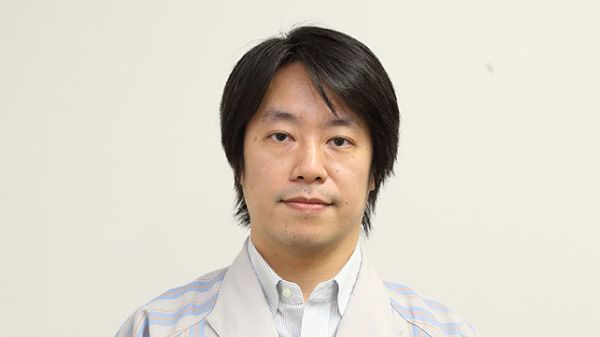
Takehiro Koyama
- Mechanical design
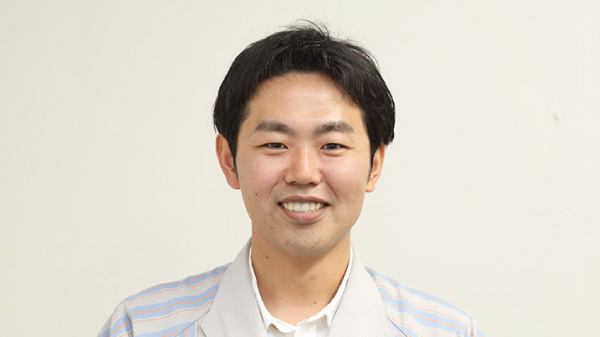
Junya Ichimura
- Optical design
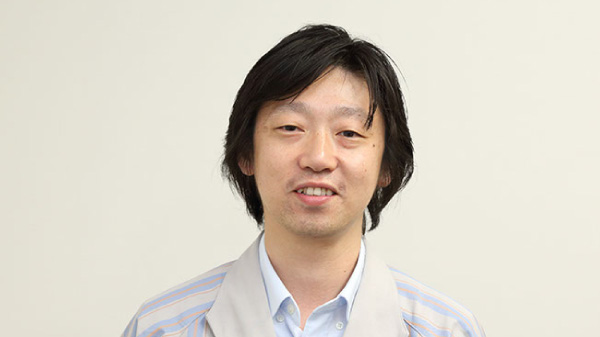
Kazuyuki Kuratomi
- Electrical design
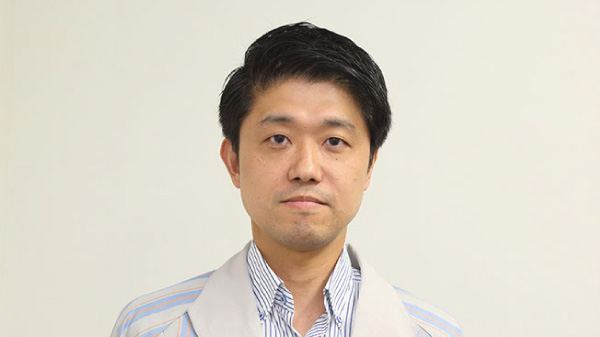
Masayuki Abe
- LCD device design
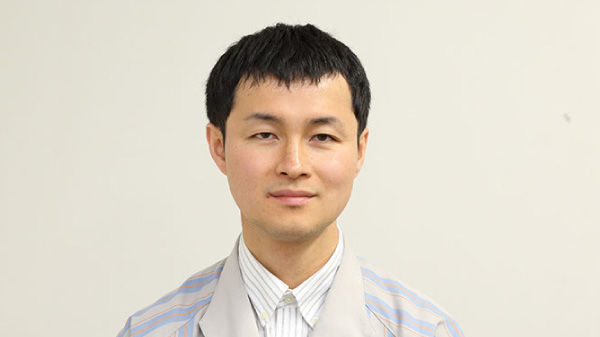
Yuichi Ishiwata
- Image quality design









